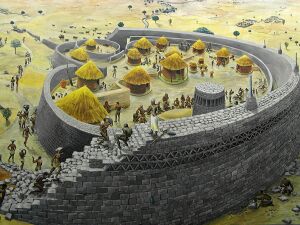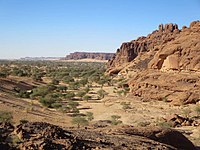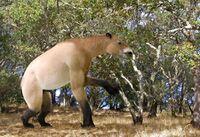Tulura
This article is incomplete because it is pending further input from participants, or it is a work-in-progress by one author. Please comment on this article's talk page to share your input, comments and questions. Note: To contribute to this article, you may need to seek help from the author(s) of this page. |
People's Gadaa of Tulura | |
|---|---|
|
Flag | |
| Capital | Arimal |
| Largest | Khasrin |
| Official languages | Afaan Tuluraa, Barriset Swahili, Ge'ez |
| Demonym(s) | Tulura, Tuluran |
| Government | Syndicalist Gadaa Confederacy |
• Abba Gadaa | Nasaar Abdii |
| Area | |
• | 6,398,368 km2 (2,470,424 sq mi) |
| Population | |
• 2019 census | 151,852,865 |
• Density | 23.73/km2 (61.5/sq mi) |
| GDP (PPP) | estimate |
• Total | $3.73 trillion |
• Per capita | $24,580 |
| GDP (nominal) | estimate |
• Total | $3.12 trillion |
• Per capita | $20,571 |
| Gini | 0.411 low |
| HDI | 0.894 very high |
| Currency | Tuluran Rupee (T₹) |
| Date format | dd/mm/yyyy |
Tulura is a sovereign state in eastern Scipia. It is bordered by Fahran to the north/northeast and Charnea to the west/northwest, as well as the Ozeros Sea to the east.
History
Ancient Zustrum
Bronze Age Tuluran civilizations formed in the Gombakori Rift Valley in 2400 BCE, known as the ‘First Ziggurats’, ‘Badlander Tribes’ and ‘Highland Kingdoms’.The ancient Zustrum civilization would rise from the city of Bekema around 1300 BCE, and form a tribute-based empire. Zustrum expanded south to conquer the Highlanders, while colonizing the floodplains at lower elevations in 800 BCE. Sosfarian Highlanders would introduce more advanced smelting methods and usher in the Zustrumic iron age.
Zustrum itself would introduce complex irrigation systems and rotation agriculture in the south, creating a population boom. Centralization under the great Administrator and ruler, Xubel the Wise, would form a strong base for his usurping war-loving successor, Elet the Bloody. She would expand Zustrum north into the Badlands, and lead war parties as far as Akhadees, declaring herself a living Goddess. This started the trend thereafter of Zustrumite rulers being seen as ‘God-Kings’ to legitimize their rule.
Following Elet’s reign, Zustrum would flourish as an advanced civilization stretched across northeast Scipia. This period of peace would see a time of political intrigue and scientific advancement. The reign of Malik the Builder during the Xabash Dynasty would be the apex of this golden era, with the construction of the Eight Great Ziggurats attributed to the Zustrumic gods. After the passing of a ruler, the Zustrumites would construct obelisk in their honor. Great administrative reform was pursued as well as great liberties, slavery was outlawed throughout the Empire.
By 400 BCE the empire would start two hundred years of instability and civil war brought on by sudden blight. Famine would incite revolt and by 120 BCE Zustrum was in its last years. The Aljito Invasion was a period in which Aljito people displaced from the ‘rice revolution’ in Mundaqar migrated east, raiding Zustrum and when the empire finally collapsed, settled all the way to Fahran. The Aljito Cities were stone-walled cities that were heavily fortified. Throughout the interior, the cities became centers for Trans-Scipian trade. The Aljito Settlements were rather insular and didn’t develop large empires, but did form strong, neutral confederations throughout Tulura’s history.
The Charnean Conquest officially ends the Zustrum period, an age of feuding states composed of Aljito, Charnean and varying Semite factions.(still working on this)
Mesfid and Almurid Caliphate
From the Gombakori Highlands descended the Sosfari clans, the few who had managed to fend off the apocalyptic Charnean and Aljito Invasions. In 951CE Mesfin led his clan on a conquest, leading a holy war across Sosfariyya and soon went north to conquer Old Zustrum, where he declared ‘The Caliphate’(Qallu), known historically as the Mesfid Caliphate. Mesfin formed his army on the basis of freeing slaves and spreading the word of god. The multicultural army grew large and formed Old Tewanya, the precursor to modern Tewanya, the official language of Tulura. Tewanya formed as a pidgin among the ranks of Mesfins army and evolved into a language of several dialects as the religion spread. Tewanya after Mesfin’s death would be a holy language.
In the later half of the Mesfin’s life, he would pursue reform in his caliphate and expand literacy, laying the foundations of Azdarin. Mesfin’s Enlightenment was a period of most extensive reform, with Mesfin introducing Tawaquf and embarking on a pilgrimage of his own after the death of is Seeress Amsalech. In his legend he found enlightenment and returned to bring about great political and social reform, incorporating indigenous Sosfaric democracy(known as 'Gaxad') across the empire. It is theorized these reforms came about due to instability with the subjugated north and internal power dynamics as Mesfin struggled to control the intrigue within his court. This is a consensus among most academic historians, more Yen scholars are recognizing the consensus.
After Mesfin’s Enlightenment, it is told he retreated into peace and passed his empire on to his adopted son, Temesgen. Historical records indicate Mesfin may have committed suicide, conservative Azdarin scholars commonly contest these findings. After Mesfin’s death, political and cultural tensions between the north and south would cause the division of the Caliphate. The Almurid Calphate rose in Northern Scipia while the Mesfids retreated back to Sosfariyya, officially dismantling after the passing of Temesgen.
Within the land, the ‘lifae Yen concentrated in the north in Zustrum, Qarst and Maboryod(modern day ‘Mundrei’), as well as Fahran and Almadis. The Sahb were most concentrated in the south in Gombakor and Sosfariyya, what was now being called ‘Tulura’ by northern latin contemporaries. In the south, Gombakori and Sosfari Tulurans formed varying Caliphates; ‘lifae in Maboryod and Qarst pursued more secular Sultanate governance.
The prominence of rule by Caliphs(or ‘Qallu’ in Tewanya) in Tulura at the time came from the domination of the Almurid Caliphate in Gombakor. Before, the Sahb held mystic and animistic thought in their interpretation of Mesfin’s teachings. Almurid rule would firstly establish the Sahb denomination and give it structure, ruled by northern aristocrats and religious scholars. Then strictly prohibited Azdarin mysticism or the rise of indigenous animism. The decline of the Almurid Caliphate would lead to a mystic renaissance in Sahb Yen thought, as well as further division in the ‘lifae and Sahb schools.
Yen Wars Period
(Wars with christians, sahb vs ‘lifae struggles, SR and Mutul open ports, northern tulura is slowly consumed by the Hellenic Empire, wars with the Hellenes ending with the ‘Tarsan Invasion’/Crusade.)
Candace Rule of Tulura
(Christian Nubians basically held as direct descendants of the original Zustrum rulers, backed by the Tarsans to conquer Tulura. ‘The Candace’ rule throughout the late 19th century until…)
Ten Thousand League War
(still needs discussion i guess, revolution overthrows monarchy and that perhaps triggers this war. Through this war Tulura industrializes, nationalism, resettlement, Sosfari ethno-nationalism)
Government and Politics
Federal Council
The Federal Council(ነቲራክ፡ካላርየ Nethira Khalarye), is led by the Amek Yadai(ዓ፡መክ ያዳ፡ኢ), Elected of the Assembly, the Head of State who moderates debates within the council and guides executive policy. The Amek Yadai does not retain full executive power, as the Council must consent to policy and Federal decisions, however takes up the role as leader. Below the Amek Yadai is their Directory, the cabinet of the Federal Council, then are the two Vice-Amek Yadai's, who perform administrative task and appearances alongside. The Federal Council is composed of six primary members. Five members from the Five Natural Government Parties and the Amek Yadai, elected by the National Assembly. They all serve with their generation in the National Assembly for ten years and then ascend into a passive mentorship to advise the following government.
Legislature
The National Assembly(ዋሃግ፡ቱ ያዳ፡ኢ Widhegtu Yadai) can be viewed as Tulura's legislature, even though the Wetek Treaty defines the Assembly as the confederation's paramount institution holding the most power. The National Assembly is a participatory institution that is consensus-based similarly to the Federal Council. It is composed of Assembly Members from the Five Natural Government parties.
Members serve ten years and then retired into the overseeing mentorship, a semi-retired passive role to mentor the succeeding assembly. This is known as the Old Assembly(ጠሉ ያዳ፡ኢ Thelu Yadai), and they serve indefinitely after ten years in the Thelu Yadai until their passing or when they decide to retire.
Law
Tulura's judicial system is steeped in Tedros Law as structured by the Wetek Treaty. It is also greatly influenced by Dharukji Azdarin Law, one of the more liberal Yen Law forms. Tedros Law aims to mediate the judicial process between the Tuluran States while creating a system of common law, it does this by taking Yenist moral codes and implementing them as standard codes of conduct across the country. Tedros Law also establishes the Khir system, protecting the judicial autonomy of each state but defining cross-state judicial interactions. Tedros law can be defined as polycentric, as Tulura maintains no central court. Temporary national courts may form to overlook impactful disputes or cases.
Military
Power to command the Tuluran Federal Armed Forces(TANAT; ት፡ሎር ነጢራክ ት፡ኡሉራ T'lor Nethirak T'ulura) resides in the Federal Security Council. Headed by the Amek Yadai, with General of the Gate(ጻዝ፡ናክ Tsaznak), Admiral of the Storm(ቨዛዳህሩ Vezadahru) and Marshal of Thunder(ሞኳዲሩ Mokwadiru) under them in advisory roles with veto power of military decisions. The three military commanders within the security council are heads of the Army, Navy and Airforce.
Currently, TANAT has 480,000 servicemembers, with around 270,000 active and the rest in reserve. Military service is voluntary, however conscription may happen in wartime. The approximate military budget is $124.8 billion. Tulura maintains a moderately sized but flexible mobile land force. The Airforce operates with 12 active air wings across the country, mostly logistical and strategic wings in support of the army. The navy is focused on fast coastal defense and projection into the Ozeros sea, operating four helicopter carriers and an unspecified submarine fleet.
Climate & Geography
At over 2.5 million sq km with the Ozeros Sea to the east, Tulura lies within a varied transitional ecoregion of semi-arid and temperate grasslands, savannas and steppes on the Tuluran Plateau. The topography of the Tuluran Plateau is mainly flat in the central regions, surrounded by the Nesai Highlands to the south and the Gombakor Mountains along the west near the border, the tallest mountain is Mt.Akarul at 6,183m. The Tuluran Plateau is vast and expansive, spanning the area of much of Tulura at 1.5 million sq km and an average elevation of up to 2,500 to 3,000 meters. The southern Nesai Highlands, combined with the western Gombakor Mountains create a rainshadow in west-central Tulura, comprising the arid steppes of the Kalahay Desert that extends into the east and north.
Tulura is typically hot, sunny, dry and somewhat windy all year long, annually experiencing low precipitation except in the more wet tropical areas in the south. Relative humidity is rather low inland, however the coast experience on average more humidity and rain. Average temperatures across the Tuluran Plateau vary between 31 and 36°C, with more moderate temperatures year-round along the coastal areas. At it's highest, the Tuluran Plateau is rather temperate, with a subtropical highland climate.
Wildlife
The vast Great Tuluran Plateau, Kalahay Desert and Zaneda Forest, are the three main defining ecological mega-regions of Tulura that harbor the country’s many fauna. Most of Tulura is a variation of savanna and rough terrain, spanning the Great Plateau that is home to some of Tulura’s most well-known species of grazing megafauna and predators. The most predominant predators being the cheetah and hyena, who’s main prey varies from small mammals such as rabbits and meerkat’s, to large mammals like the Urewil Giraffid, Gazelle and Antelope. Scipian buffalo are also quite widespread in Tulura, though most are domesticated quite a few wild populations exist.
Most animal populations migrate with the monsoons to local watering holes, crossing the dry Tuluran grasslands and Kalahay Desert in treacherous journey’s. One of the most notable grassland grazers is the Numwi, known as the Tuluran Bear or Sloth. The Numwi is roughly 1.5 to 1.8 meters tall and grazes on the grasslands and browses local trees. The Urewil Giraffid is mostly around light forest, though also grazes on the the Tuluran plateau from time to time. The Urewil is known as the Tuluran Moose, due to its physical similarities, it is one of the leading migratory savanna animals. Though not many small mammals exist on the plateau, striped Tuluran Aardvarks do thrive, as does the Wild Scipian Dog, a descendant of the domesticated Scipian Hunting Dog and Tuluran Cattle Dog.
Further south near the Zaneda Forest exist the striped zebra-giraffe(Thuwes), usually roaming the forest and its outskirts. Along the outskirts of the southern forest into the more lightly forested savanna of central Tulura, are the Q’ynduhu known as the Tuluran Elephant. The Tuluran Elephant is the largest land mammal in Tulura, standing at 3.8 to 4.5 meters tall. It doesn’t graze as much as it feast on the tall trees and bush near the Zaneda Forest. Due to intense deforestation however, the population has taken a dramatic decline alongside the zebra-giraffe. Small mammals such as porcupine, hog, hyrax and the mongoose are widespread in heavily forested areas as well.
Reptiles are widespread across Tulura, mostly in the more moist south however, with over one hundred species of snake existing in the south, most prevelant are mambas. In the north, the Tuluran cobra is feared as the most dangerous snake in the country. Tortoise are common behind snakes too, as are small lizards and large land lizards, such as the Ghetsew Dragon. A wide variety of chameleons exist in southern Tulura, observed as holy animals by some locals in line with their traditional beliefs.
Birds such as the Lesyala Vulture and Tuluran Flamingo are among the most widespread and known large bird species in Tulura. The Scipian Hawk takes leisure as the most dominant predator of the skies over the Lesyala Vulture however, living among the highlands but having a wide hunting range onto the plains, hunting small mammals and fish from lakes and rivers. Tuluran Flamingo’s come with the seasons, settling in the lowlands during intense monsoons to breed and lay their eggs. Then flightless Wattled Ibis, Tulura’s national bird, lives in highlands and the savanna steppe mostly, eating small insects and fruits. The ostrich also takes hold among the savanna, a fierce prey of cheetah and hyena.
Due to the influence of Azdarin religion, sealife flourishes near Tuluran shores, as most sects forbid the consumption of any sea creatures, defining whales, dolphins and octopus as holy animals. Even land-sea animals such as crab, which are permitted consumption because they dwell on land, flourish because the commonality of their consumption is not frequent. Because of religious law, commercial fishing is strictly forbidden in Tulura, as is tainting the sea with pollution. The Naabri Gulf Reef is massive, spanning over two-thousand kilometers of individual coral networks.
Culture
Naming
(wip) Most Tuluran naming conventions follow a matrilineal line, where the child takes on their mother's and grandmother's name. In formal circumstances, Tuluran's are called by both their given and mother-name, for example: Melesse-Habte(given-mother).













